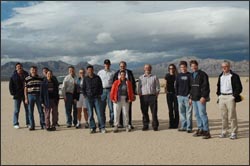Satellites projects are vastly technical endeavors. They involve years of planning, engineering and building before they are launched. Once the bird (aka satellite) has been launched into orbit, engineers are needed to oversee flight operations and insure successful communication for data down-links.
Once the data makes it to the ground, a data team processes the data into usable formats while a calibration team constantly monitors the performance of the satellite’s sensor to insure the highest level of data quality. Calibration scientists at a Landsat desert calibration field site.

Data archivists are entrusted to provide long term storage for the immense amounts of down-linked data. And through the years, data archivists must oversee the migration of older data to new data storage devices.
Scientists from an array of disciplines develop methods by which Landsat data can best meet the research needs of their field. And communication specialists help to convey the many uses of Landsat data and to teach young generations (and perhaps future scientists) about how Landsat works and how to use the data collected by Landsat.
So, from the engineers who build and launch the satellite to the truck driver who brings the satellite across the U.S. for launch, and from the calibration scientists who make sure the data is accurate to the data archivists who ensure the historic preservation of Landsat data, and from the scientists who discover new and important ways to use the data to the data end user (you!)—Landsat is people.
Learn more about the people of Landsat.
